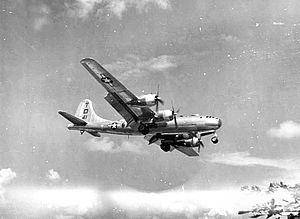The 875th Bombardment Squadron is a former United States Army Air Forces unit. The squadron was activated in late 1943 for service during World War II. After training in the United States with Boeing B-29 Superfortress bombers, the squadron moved to the Mariana Islands, where it participated in the strategic bombing campaign against Japan, earning two Distinguished Unit Citations before the end of hostilities in August 1945. The squadron returned to the United states in December 1945 and was inactivated in March 1946, and its personnel and equipment transferred to another organization.
| 875th Bombardment Squadron | |
|---|---|
 | |
| Active | 1943–1946 |
| Country | |
| Branch | |
| Role | Heavy bomber |
| Engagements | Pacific Ocean Theater of World War II |
| Decorations | Distinguished Unit Citation |
| Insignia | |
| 875th Bombardment Squadron emblem[a][1] |  |
History
editThe squadron was first activated at Clovis Army Air Field, New Mexico in November 1943 as one of the four original squadrons of the 498th Bombardment Group, an early Boeing B-29 Superfortress very heavy bomber squadron. The squadron trained in New Mexico and at Great Bend Army Air Field, Kansas with early model B-29s until July 1944, when it began its deployment to the Pacific.[1][2]
The squadron arrived at its combat station, Isely Field, Saipan in September 1944.[1] The squadron's first missions were flown against targets on Iwo Jima and Truk Island. On 24 November 1944, the squadron participated in the first raid on Japan by bombers based in the Mariana Islands. The squadron initially engaged in high altitude daylight attacks against industrial targets in Japan. It was awarded a Distinguished Unit Citation (DUC) for an attack on an aircraft manufacturing plant in Nagoya on 13 December 1944.[2]
In March 1945, the Twentieth Air Force changed tactics and the squadron began flying low level night attacks with incendiaries against area targets. The 875th received a second DUC for its actions during a low level raid on urban industries near Kobe and Osaka in June 1945. Squadron operations also included attacks on airfields in Okinawa during the invasion of Okinawa in April 1945. After V-J Day, the squadron remained on Saipan until November and reassembled at March Field, California the following month. It became one of the first bombardment units in Strategic Air Command in March 1946, but was inactivated at MacDill Field, Florida on 4 August and its personnel and equipment were transferred to the 372d Bombardment Squadron, which was simultaneously activated.[1][2][3]
Lineage
edit- Constituted as the 875th Bombardment Squadron, Very Heavy on 19 November 1943
- Activated on 20 November 1943
- Inactivated on 4 August 1946[1]
Assignments
edit- 498th Bombardment Group, 20 November 1943 – 4 August 1946[1]
Stations
edit
|
|
Aircraft
edit- Boeing B-17 Flying Fortress, 1944
- Boeing B-29 Superfortress, 1944–1946[1]
Awards and campaigns
edit| Award streamer | Award | Dates | Notes |
|---|---|---|---|
| Distinguished Unit Citation | 13 December 1944 | Japan, 875th Bombardment Squadron[1] | |
| Distinguished Unit Citation | 1–7 June 1945 | Japan, 875th Bombardment Squadron[1] |
| Campaign Streamer | Campaign | Dates | Notes |
|---|---|---|---|
| Air Offensive, Japan | 7 September 1944 – 2 September 1945 | 875th Bombardment Squadron[1] | |
| Eastern Mandates | 7 September 1944 – 14 April 1944 | 875th Bombardment Squadron[1] | |
| Western Pacific | 17 April 1945 – 2 September 1945 | 875th Bombardment Squadron[1] |
See also
editNotes
edit- Explanatory notes
- ^ Approved 9 November 1944. Description: On an orange disc, border black, a stylized figure of Vulcan in light purple and black, standing over green globe marked with yellow lines of longitude and latitude in base, and holding in the left hand twelve red, jagged lightning flashes arranged seven to dexter, five to sinister, striking a blow with a large light purple and black sledge held aloft in the right hand.
- Citations
References
editThis article incorporates public domain material from the Air Force Historical Research Agency
- Maurer, Maurer, ed. (1983) [1961]. Air Force Combat Units of World War II (PDF) (reprint ed.). Washington, DC: Office of Air Force History. ISBN 0-912799-02-1. LCCN 61060979.
- Maurer, Maurer, ed. (1982) [1969]. Combat Squadrons of the Air Force, World War II (PDF) (reprint ed.). Washington, DC: Office of Air Force History. ISBN 0-405-12194-6. LCCN 70605402. OCLC 72556.